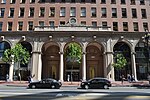Vaillancourt Fountain
1971 sculpturesFinancial District, San FranciscoFountains in CaliforniaGraffiti in the United StatesMarket Street (San Francisco) ... and 5 more
Outdoor sculptures in San FranciscoPages containing links to subscription-only contentU2Vandalized works of art in CaliforniaWorks by Canadian people
Vaillancourt Fountain, sometimes called Quebec libre!, is a large fountain in Embarcadero Plaza in San Francisco, designed by the Québécois artist Armand Vaillancourt in 1971. It is about 40 feet (12 m) high and is constructed out of precast concrete square tubes. Long considered controversial because of its stark, modernist appearance, there have been several unsuccessful proposals to demolish the fountain over the years. It was the site of a free concert by U2 in 1987, when lead singer Bono spray painted graffiti on the fountain and was both praised and criticized for the action.
Excerpt from the Wikipedia article Vaillancourt Fountain (License: CC BY-SA 3.0, Authors).Vaillancourt Fountain
Commercial Street, San Francisco
Geographical coordinates (GPS) Address External links Nearby Places Show on map
Geographical coordinates (GPS)
| Latitude | Longitude |
|---|---|
| N 37.7954 ° | E -122.3953 ° |
Address
Vaillancourt Fountain
Commercial Street
94111 San Francisco
California, United States
Open on Google Maps









